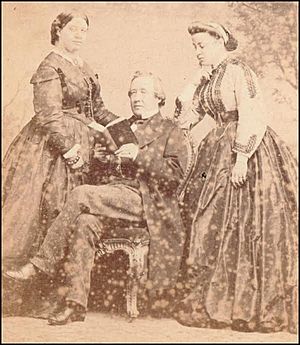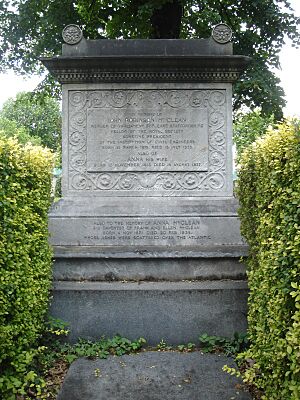John Robinson McClean facts for kids
Quick facts for kids
John Robinson McClean
|
|
|---|---|

McClean, wife Anna and their eldest daughter Mary Hall (Minnie)
|
|
| Born | 21 March 1813 |
| Died | 13 July 1873 (aged 60) |
| Nationality | British |
| Education | University of Glasgow |
| Occupation | Engineer |
| Engineering career | |
| Discipline | civil engineer |
| Institutions | Institution of Civil Engineers (president) |
| Practice name | South Staffordshire Water Works Company |
| Projects | South Staffordshire Railway, Suez Canal |
John Robinson McClean (born March 21, 1813 – died July 13, 1873) was an important British civil engineer. He was also a politician for the Liberal Party. McClean completed many big projects. For a time, he was the only person to own a main railway line. He also did good deeds for others. For example, he helped bring clean water to towns. This stopped serious outbreaks of diseases like cholera. He did this work without taking any pay.
Contents
Early Life and Education
John Robinson McClean was born in Belfast, Northern Ireland. He was the youngest of four sons. His father, Francis McClean, was an ironmonger, which means he sold metal goods. John went to school at the Belfast Academical Institution. Later, he studied at the University of Glasgow.
Becoming an Engineer
When he was young, John wanted to be an engineer for the Belfast Harbour. But he was not chosen for the job. He told a family friend that he would show them what a great engineer they had missed.
John McClean later started an engineering company. It was called McClean & Stileman. He worked on many big projects, including:
- Helping the British Government with the Suez Canal. This is a famous canal that connects the Mediterranean Sea to the Red Sea.
- Working on projects for Emperor Napoleon in France.
- Being the Chief Engineer for the harbours in Plymouth and Dover.
- Leading the Anglo-American Telegraph Company. This company helped send messages across the Atlantic Ocean.
- Being the Chief Engineer for building the South Staffordshire Railway. This railway opened in 1849.
People who study history say McClean was a very talented engineer. He should be more famous for his work. Before working on the South Staffordshire Railway, he was already helping four other railway companies. He also drew plans for the Victoria Embankment and the new Westminster Bridge in London. When London needed new sewers, his plans were the best out of 116 ideas. His plans were also the only ones that estimated the costs.
Bringing Clean Water to Towns
McClean saw that the town of Walsall had very bad water. This caused many outbreaks of diseases like cholera and typhoid. He noticed that the water in Lichfield was very clean.
He worked with powerful friends to create the South Staffordshire Waterworks Company in 1853. This company brought clean water from Lichfield to Walsall and Dudley. They used Stowe and Minster pools as water storage areas. The water pipes were laid next to the railway lines. Parts of Walsall got clean water by 1858. But the whole project took 15 years to finish. McClean was the engineer for this company, but he did not take any pay for his work.
Owning a Railway
An Act of Parliament was passed to allow it. This meant McClean could lease the South Staffordshire Railway for 25 years. This made him the first person ever to own a railway line all by himself.
By 1853, he also worked in mining. He built a railway line to serve two coal mines. These mines were on Cannock Chase. They were known as the Hammerwich and Uxbridge pits.
McClean invested money to help develop the coal fields in Cannock Chase. The mines led to new towns being built, like Chasetown and Chase Terrace. McClean helped these new communities. He provided them with schools, churches, a community center, and a library.
McClean was the President of the Institution of Civil Engineers from 1864 to 1865. This is a very important position for an engineer.
Political Career
McClean tried to become a Member of Parliament for Belfast in 1857. He ran as a Liberal Party candidate, but he did not win.
However, he was elected in the 1868 election. He became the MP for East Staffordshire. He held this position until he died in 1873.
He was also a Lieutenant-Colonel in the Engineer and Railway Staff Corps. This group of volunteers advises the British Army on engineering matters.
Later Life and Family
John Robinson McClean died in 1873 when he was 60 years old. He is buried with his wife, Anna, in Kensal Green Cemetery in London.
He was married to Anna (1813–1877). They had five daughters and one son, named Frank McClean. Their family line includes other notable people.


